The IronMaster Super Bench has been a fairly popular adjustable economy bench over the years. Used mostly in home and garage gyms, it’s one of the few decent alternatives to commercial-grade adjustable benches for beginner to intermediate lifters. It’s versatile, strong, relatively affordable, and for the average lifter the pros tend to outweigh the cons.
In this review I’ll cover the specifications of the Super Bench, adjustment settings, comfort level, accessories options, and more. I’ll then summarize the review towards the end with a simple pros and cons list. Hopefully by the end of this review you will know all there is to know about the Super Bench, and know whether or not it will meet your needs.
- Super Bench Specifications
- Assembly
- Strength & Stability
- Adjustments [flat / incline / decline]
- Adjustment Mechanism
- Pad/Seat Comfort
- Accessory Options
- Pros and Cons list
- Review Summary
Super Bench Specifications
- frame footprint: 18¾” x 41″
- pad dimensions: 10″ x 44″ x 2″
- pad height when flat: 20″
- frame material: various-gauge steel
- pad angles: +/- 0º, 5º, 10º, 20º, 30º, 40º, 50º, 60º, 70º, 80º, 85º
- seat angle: always perpendicular to pad (90º)
- seat heights at max 85º upright: 12″, 14″, 16″
- max capacity: 1000-pounds flat, 600-pounds incline
- usage: home/garage gym; light commercial use
- origin: China
- warranty: 1-year on pads, 10-year on frame
- price: $319/$388 *
* Super Bench requires the purchase of a crunch accessory to utilize the decline function. The second price listed is the total price for the Super Bench and that accessory.
Assembly Required?
The IronMaster Super Bench ships completely assembled except for the feet – you have to attach those and tighten four whole bolts. It took me longer to get the bench out of the box and free of packing foam and tape than it did to assemble it. The crunch attachment did require assembly, but it took me no more than 10-minutes.
Super Bench Stability & Strength
The frame of the Super Bench is made from a combination of 11, 12, & 13-gauge steel tubing. Critical components are even beefier, for instance the large, notched adjustment wheel is 2-gauge steel, and the top of the support post that serves as the pivot point for the back pad is 000-gauge.
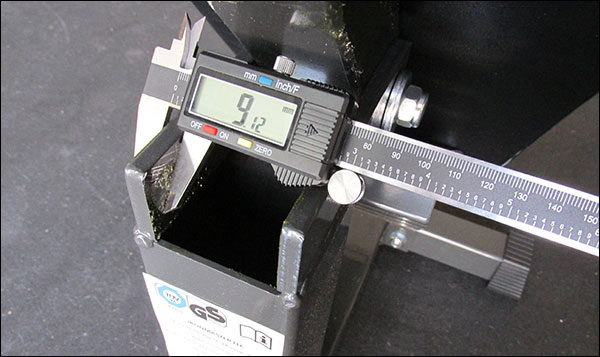
The lighter gauge components appear to only be used in places where it is safe to use them. For example, the center support post and its base are 11-gauge, but the feet on either side of that base are only 12-gauge. 13-gauge components seem to be reserved mostly for accessories and their connection ports.
So is it stable? Absolutely it is. It doesn’t wobble, rattle, shake, tilt, or twist – it’s rock solid. When you consider how this bench is designed with 100% of the weight converging on a single support post, the stability is really quite impressive. To be honest, because of this unique design and the fact that it is an imported product, I was truly expecting a moderate amount of play in the pad, but surprisingly there is none.
In terms of strength, the Super Bench has a 1000-pound max capacity when flat, but only 600-pounds in the incline positions. This huge difference in capacity might be due in small part to how weight is distributed on the frame at high angles, but I believe this lower max capacity has a more to do with the seat than the bench frame. The seat is just of an odd design, and one that is subjected to multiple forces when loaded. Couple this design with lightweight, 13-gauge steel tubing and you have a seat that can only handle so much.
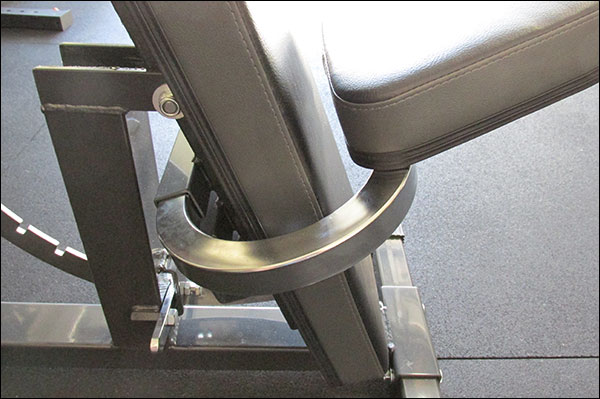
I’ve personally had 400+ pounds in the higher incline settings where all of the weight is on the seat, not the pad, and all was well. Be that as it may, if you’re a 250+ pound man with a strong incline bench press or military press, you’re gonna be getting really close to that max. In other words, powerlifters and other strong lifters should find a commercial bench.
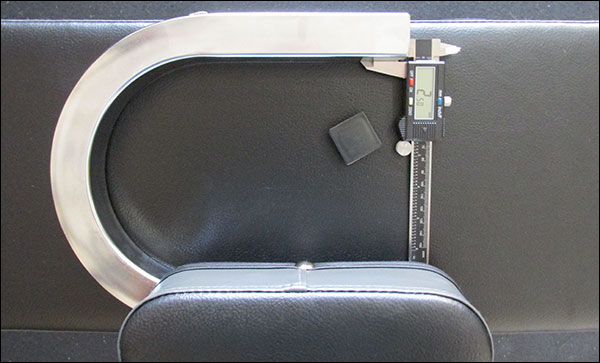
Overall, the Super Bench is incredibly stable and plenty strong for a home or garage gym. I have been pleasantly surprised at how secure it feels under me for such a versatile, low-cost, and imported bench. Due to the seat though, this bench cannot replace commercial benches for stronger, heavier athletes.
Super Bench Incline Angles
The IronMaster Super Bench has a multitude of adjustment angles including 0º, 5º, 10º, 20º, 30º, 40º, 50º, 60º, 70º, 80º, and 85º! There is literally nothing to complain in terms of exercise variety. You can bench press, incline bench press, military press, and overhead press at varying angles.
Flat Super Bench – the pros and cons
One of the best features of the Super Bench is that it has a normal, rectangular back pad. Incline benches tend to have narrow, tapered back pads and large gaps between the pad and the seat, while decline benches get wider at the base of the pad to accommodate the width of both legs. Neither of these tapered pad styles are ideal for flat benching.
IronMaster had the unique idea starting with a flat bench and looking for ways to turn that into a good adjustable bench. The solution they came up with was to utilize accessories; components that attached when needed, but could be removed when not. This design is clever, and it makes the Super Bench a much better flat bench than many other incline benches. All that said, the Super Bench still has its own issues when flat.
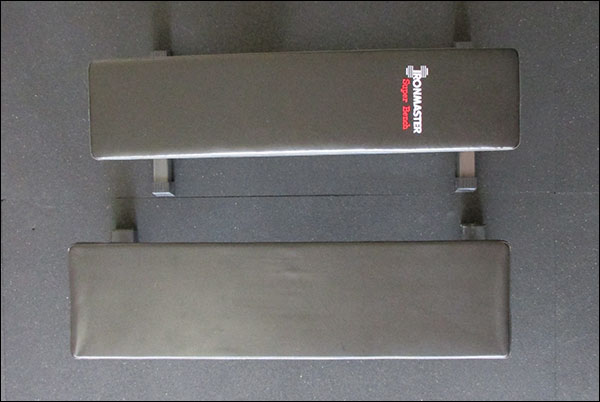
The first issue is the overall dimensions of the pad. For flat bench press we really want a pad that’s 12″ wide and about 48″ long. The Super Bench is only 10″ x 44″; pretty small. The length is tolerable, but the width is problematic. 10″ doesn’t provide enough surface area to dig in the lats and keep the shoulders supported unless you are just tiny. This is a shoulder health issue over the long term, so this pad would be infinitely better at 12″ wide.
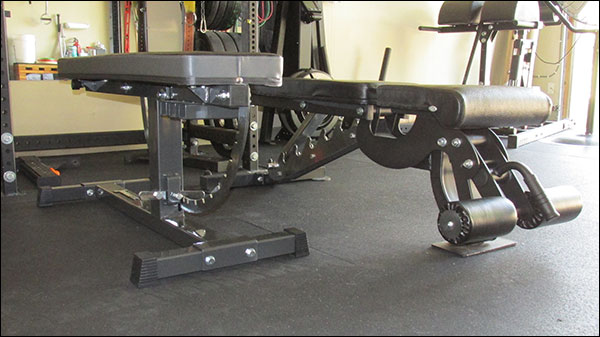
The second issue is the distance from the ground to the top of the pad. The norm for flat benches is 17-18″, but the Super Bench is 20″. This is just enough distance to make foot drive a challenge, and that is not what you want. Fortunately, this particular issue can be corrected simply by placing blocks or plates at your feet. Sure it’s an another thing to do, but at least the issue is solvable.
These size issues aside, the Super Bench is still one of the best adjustable benches for flat bench pressing; at least for every-day lifters. Professionals have a couple of reasons so far to advance up to commercial-grade.
Incline Super Bench – pros and cons
The Super Bench has a lot of things going for it in the incline positions, but there are three major aspects worth drawing attention to – the first being the seat.
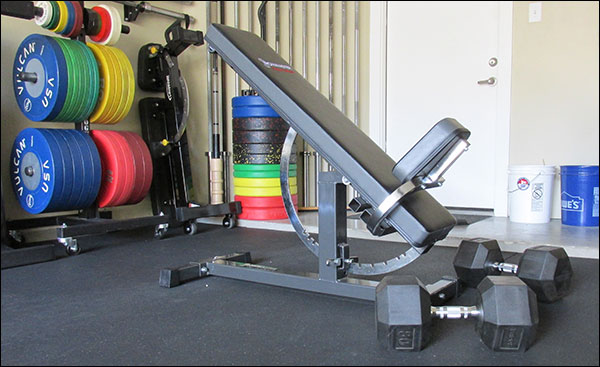
Since the seat attaches to the frame only when incline positions are used, it didn’t need to be shaped in a way that takes into consideration the other positions. The benefit of this is a seat of an appropriate size and shape, and (in this case anyway) a seat that is always perpendicular to the back pad. A perpendicular seat is one that you won’t ever slide out of or even feel like you’re sliding out of.
Next is the frame. Rather than being a tripod-style frame, the Super Bench has a frame like a normal utility bench. That is, it makes contact on all four corners. While both styles are very stable overall, the tripod benches get a little shaky in the highest incline settings. Not an issue with the Super Bench.
Finally, I do have to remind you that the seat has a relatively low max capacity at only 600 pounds. Not an issue for the average lifter, but stronger lifters will need a beefier unit.
Decline Super Bench – the pros and cons
Since all 11 of the available incline settings are also decline settings, there are far more decline settings than will ever get used. This isn’t a problem or anything, just keep in mind that only the first few are of any real use. You should also know by now that utilizing the decline positions requires the purchase of the $70 crunch/sit-up attachment.
The Super Bench is just as sturdy declined as it is when flat or inclined, and the crunch attachment is adjustable for height so just about anyone should be able to use it. It is true that the back pad is a bit short for a declining bench, but because of how the bench works most of your lower body is wrapped around the crunch attachment while the back pad just needs to be long enough for your head, trunk, and butt.
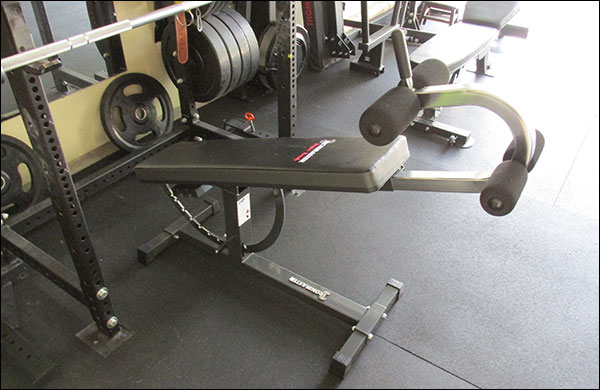
There are two drawbacks to declining with the Super Bench, and they both have to do with pressing. First, you will definitely be reminded at how narrow the pad is when you decline bench press.When at negative angles, the shoulders feel like they are hanging off even more than when flat benching. It’s not great.
Second, because of how the crunch attachment requires your legs to go up and over the top rollers and because of how high those rollers are, there is simply no easy or safe way to get into position while wielding heavy dumbbells. With normal decline benches, the legs just hang over the end of the bench and the feet hook on rollers far below the pad. This allows you to hold dumbbells at your thighs, walk in, and lay back. You actually have to climb into the Super Bench when in decline mode while holding dumbbells at about chest level. It’s a nightmare. You need a spotter or IronMaster’s $300 dumbbell trays to make this work.
All things considered I still think this bench does pretty well overall in all three positions for average lifters. You still have to weigh the advantages and disadvantages of each position yourself though, of course.
Adjustment Mechanism
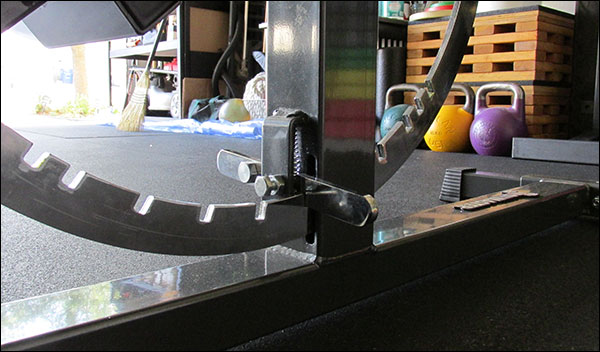
Adjustments are made using a foot lever at the base of the bench. From one side you use your foot to press down, and from the other you pull up with your toe. The picture paints a thousand words, so suffice it to say that it’s simple and quick to use, secure, and all of the components are beefy. It’s also no where near your feet when actually using the bench so you won’t be hitting it accidentally.
Super Bench Comfort
The 2″ foam padding of the back pad is thick and firm; it does not compress easily like cheap pads. It is both supportive and comfortable, but like I’ve mentioned it’s very narrow. It’s also not 3″ like the product description says – even if you include the support board.
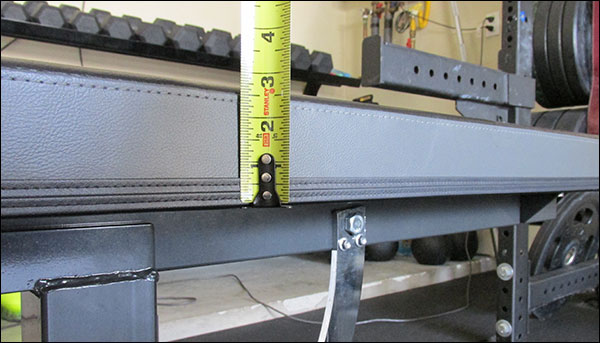
The seat has the same firm foam used in the back pad, so it too is very comfortable. The shape of the seat is compact enough so that it won’t interfere with leg positioning, but still large enough to do its job. The right angle created by the seat and the pad is perfect; very secure feeling in all incline positions.
Super Bench Accessories
The Super Bench has a wide range of optional attachments. A handful of them may be worthy of consideration, but most seem unnecessary for even a moderately equipped home or garage gym. The available attachments include:
- crunch/sit-up
- dip station
- pull-up/chin-up station
- lat pulldown tower
- leg curl/extension
- preacher curl pad
- dumbbell spotters
- wheel kit
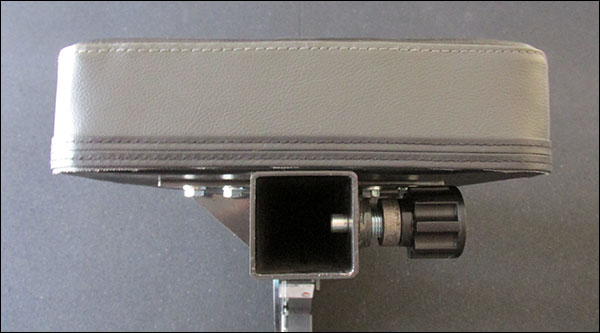
The two attachments that stand out the most to me are the crunch/sit-up attachment that is required to make full use of the Super Bench’s decline features, and the optional wheel kit for easy mobility around the gym. The lat tower may also be appealing to those of you who miss having access to low rows and lat pulls, but at over $400 it’s a pretty expensive accessory, and also quite large.
Crunch/Sit-up Attachment
The Crunch/Sit-up Attachment runs for $69, turning a $320 bench into a $400 bench. It can definitely be worth having if decline work interests you, and it does function exactly as intended, but it feels cheap and overpriced to me.
The problem is the foam rollers. They are too small and uncomfortable, and they have no vinyl covers. The foam feels harsh against the skin under the knees, and it only gets more irritating as the foam gets damp from sweat (which incidentally just gets absorbed into the foam like a sponge – gross.) I wouldn’t complain if this accessory was $25, but for nearly $70 there should be vinyl. Comfort and durability would be greatly improved, and it could easily be sprayed and wiped down after use.
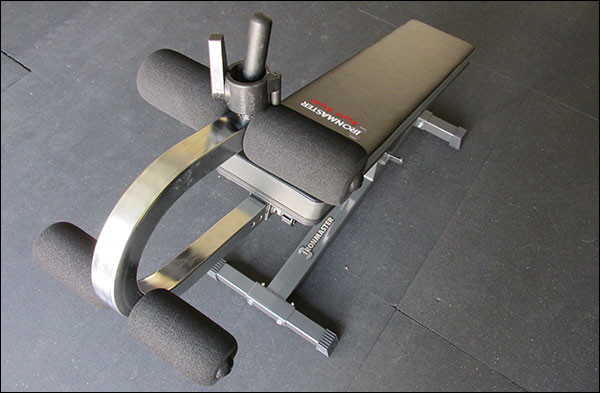
Crunch attachment – small rollers, no vinyl cover. Muscle Clamp is to illustrate size.
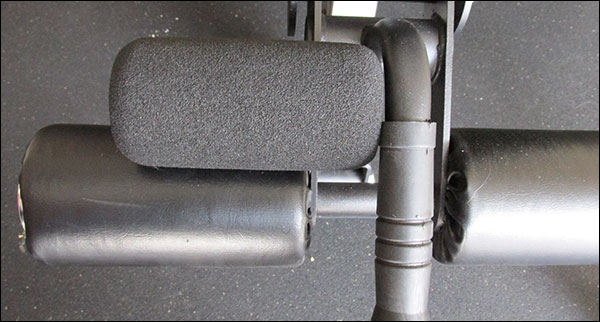
IronMaster’s foam rollers next to vinyl rollers of Rep FID Bench.
In any case, the attachment works as intended. You can crunch, sit-up, and decline bench press to your heart’s content with it. Hell you probably should own this attachment, it’s just not a very good value, and that’s a bummer.
All Other Attachments
To be totally honest, I did not want to drop close to a grand on accessories that I’d never use just to be able to add that content to this review. My interest in the Super Bench is 100% about the bench itself, not the accessories. I also think that the majority of athletes who buy this bench do so because it’s a good fully adjustable bench at a fair price, not because you can do preacher curls or machine exercises off of it.
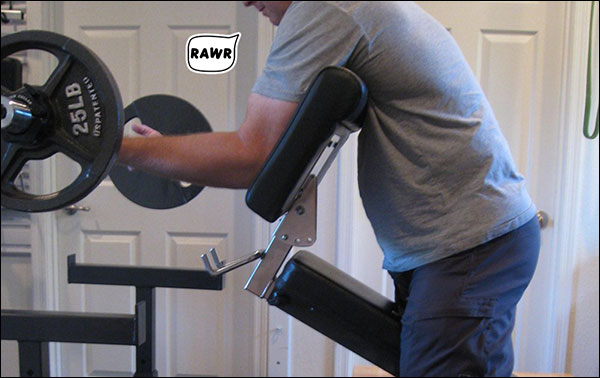
Fortunately this bench and its multitude of accessories has been reviewed dozens of times already, so there is no shortage of content out there regarding those accessories. When you want the most detailed information on the bench itself – the pros AND the cons, well you’re already on the right page.
Warranty Information
The Super Bench has a 10-year warranty on the frame, and 1-year on all the wearable parts. Wearable parts include the pads, rollers, and rubber feet.
If I were you I would keep a real close eye on foam rollers (if applicable). If you use these heavily and find that they are shredding apart and starting to stink, request replacements before your year is up.
Pros and Cons List for IronMaster Super Bench
Pros
- Assembly is super easy; only four bolts. You will need your own tools though.
- Strong steel and tight assembly tolerances makes for impressive stability.
- Load-bearing rubber feet offer additional stability on uneven surfaces.
- Very high 1000-pound max capacity flat; 600-pound in seated incline positions.
- Tons of adjustment variety. 11 total lock-out settings from 0º to 85º.
- Adjustments are quick and easy to make with the foot lever, and very secure.
- The full removal of seat and crunch attachment allows the bench to retain a normal, rectangular shape when flat. Very high-value feature.
- Seat size, shape, and angle relative to back pad are all perfect when inclining.
- Foam padding is thick and firm – very comfortable and supportive.
- Super Bench base price is very reasonable, and includes shipping.
- Feedback on IronMaster customer service is very positive.
- All the available accessories will be a big selling point to some, but not everyone. Fortunately, the availability of accessories or even a lack thereof don’t impact the value of the core bench.
Cons
- The base price is great, but after adding wheels and the crunch attachment, the price is creeping into commercial-grade pricing.
- Bench in the flat position is too high. 20″ is an unfavorable height for the bench press unless the floor is built up around the bench.
- The 10″ pad width is too narrow to accommodate strong, strict-form bench pressers. Decline benching feels even worse than flat benching in this regard. This can easily be viewed as a safety issue, as bad form + narrow bench = rotator tears.
- Low seat capacity combined with pad sizing make this a poor choice for strong lifters. Hell of a deal for beginners and intermediates, but not an end-game bench.
- Decline dumbbell press is a no-go without a spotter. Decline barbell bench only.
- Accessories are not made to the same standards as the bench; they are overpriced.
- Foam rollers are super cheap. They are uncomfortable, small, unprotected, and they are sponges for sweat and moisture.
- Imported product – Not made in the USA.
Super Bench Review Summary
The pros of the IronMaster Super Bench seem to outweigh the cons for the average gym rat. It has its peculiarities, but this is one of the few adjustable benches that is pretty well rounded in all possible positions. That is to say, you don’t have to choose a bench based on a preferred position and then settle for meh when you use the other positions. It would be superb if all the components required to make full use of the bench were included, but alas, they are not.
There are still plenty of better commercial options out there of course, but for the money this bench has no equal. If you plan to use all three positions then this may be the bench to buy. If you don’t care about the decline positions at all, then you could probably secure an incline bench with a higher capacity. If capacity doesn’t matter to you, pull the trigger on the Super. It’s still a great incline bench.
As I mentioned, I don’t personally value the accessories much; save for the crunch/sit-up attachment. They aren’t even factored into my overall opinion of the bench. However, an argument can be made that if you are interested in them, that is all the more reason to go with the Super Bench.
So who should avoid the Super Bench? Well the max load on the seat is low enough to be a concern for heavy, above average lifters. Getting to within 10-20% of that max seat load capacity is not that hard to do. Safety should always be priority one; don’t press your luck. Also, big lifters will dislike the 20″ high, 10″ wide pad for benching.
Basically, if two or more of the listed cons bother you, I’d look towards commercial units. If those cons don’t impact you, well I think you’ll love the Super Bench.
Check out the IronMaster Super Bench

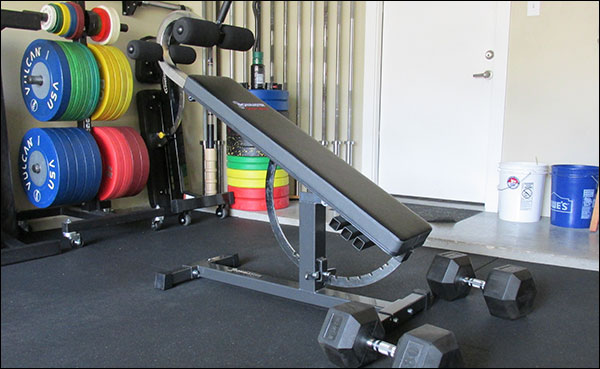
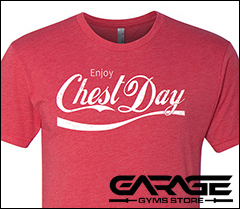
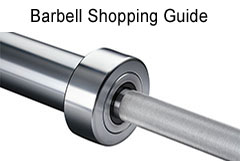
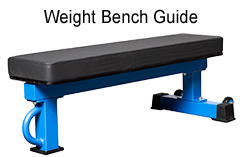
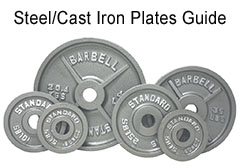
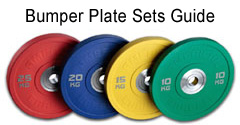
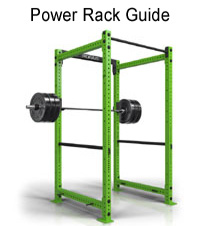
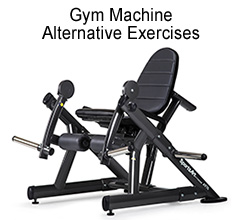

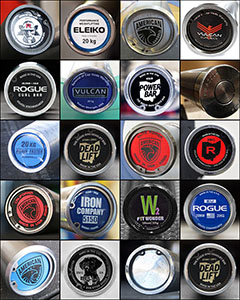

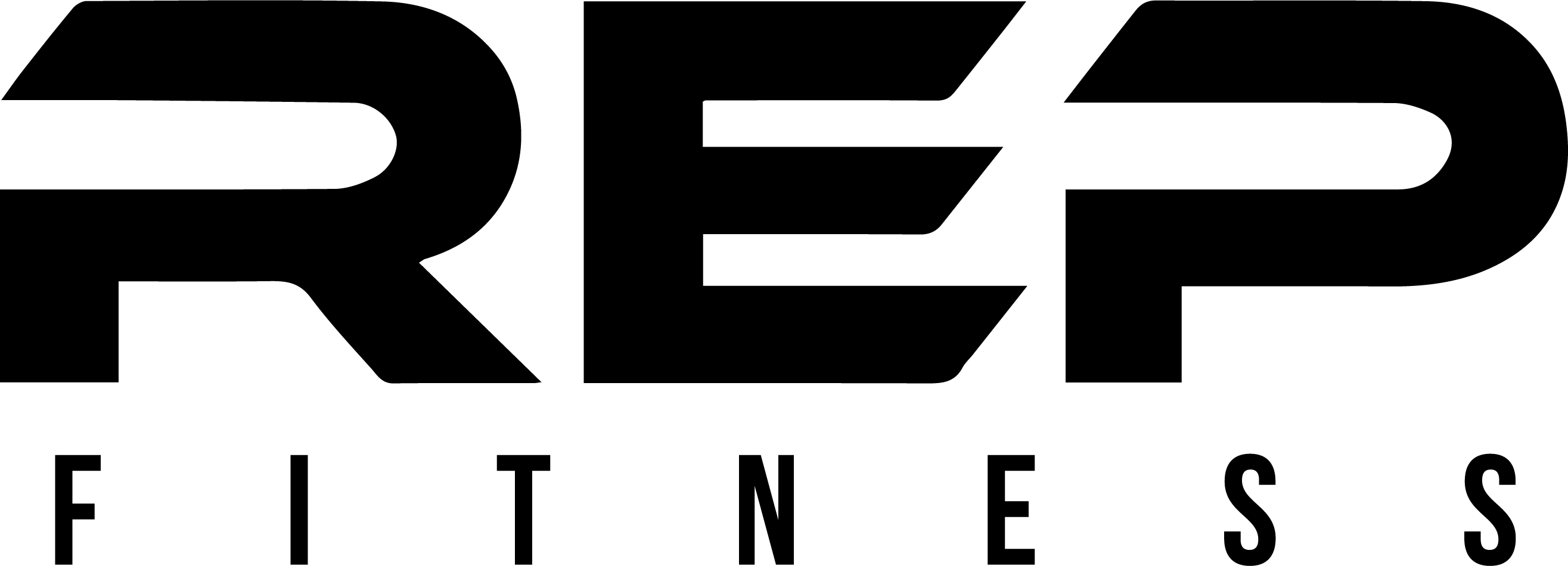
a bench isnt à Bar ! i like this bench type… few money but very correct quality. i give this recomandation my friends Irons Warriors (no racism….powerlifters B.B ..Weightlifter…Strongmen…..and C.F if you wants lool.) invested your money in CERTIFIEDS Bars (IWF Eleiko if possible….IPF all brands). but if you know a good bencj no expensive….go buy it quickly !!! i was Ex “S.H.W” PowerLifter fan of oly W.L. (50% in gym 50% in homegym training). 1986 lbs in big 3 vritual (added my best results in all competitions). no far of 450 lbs in jerk..during 15 years i just own a poor bench i. home gym. .very solid but cheap…and i obtain international level results in one parts of movments ! just because i have allways great BARS…BAR is angular stone of your carreer.
The bar is the most important! I have to review something else every once in a while! Eleiko NxG Performance Bar review coming soon, just for you !
Eleiko is great Brand
Having owned and sold 2 of these benches your review is spot on! The accessories are great if you get them as a package deal (ie, used equipment), but I wouldn’t spend on anything other than the ab/crunch. The reason that I’ve had 2 is that they’re so versatile for a home gym. After I sold the first, I realized that other flat benches although at a lower height didn’t provide the variety that I needed, hence a second purchase. You can pick these up used with at least 2-3 accessories for $200-250… nothing comes close to value for money.
Thanks again JB for another great review!
Thanks! So have you ever noticed any deterioration in stability over time? Does it stay together well with use? I tried to find one used but ultimately just ordered it new. Everything is so tight and stable out of the box but I haven’t had it nearly long enough to rate its life expectancy.
Overtime there’s a very very little play side to side, but it’s not noticeable once weight is planted. As for the pad, the side and top corners will show wear.
Alright cool, thank you Brent
i see a 1000 pouds capacity in flat (for bench press classic) its very suffisant like my old bench same maxi load in flat position.. ! enormous for 95% of people ! for illustred that , in my prime i best Raw bench is 524 LBS (with stop time on chest) at 331lbs of bodyweight..
.(TOTAL WAS :855 LBS !!! I WAS 145LBS OF SAFETY MARGIN OR FOR “BOUNCE'” ASSISTED REPETITION lol but not for me… i never work with this method ). my maxi bodyweigt was 368lbs but my overweight give me just overpower…IN SQUAT…and a little in D.L…but my bench at these no habitual bodyweight no exceed 512lbs.(880lbs me and my bar).. i keep allways 120lbs of safety margin …. just for explain than 1000 lbs is a very good capacity …if your not a ” Scott Kazmaier” this bench is suffisant for all raw work (suited /equiped bench is for me a dangerous praticea and in an homegym is an total heresy)
in a bench press, Bench is the most “lucky” of triptyque .(i dont count the lifter) Bar and rack stand support 90 % of weight Stress !!! lifter’s body absorb quasi totality of brutal stress fluctuation and bench is protected ! but bar and stand usualy support hits metal against metal !
Do you think you’d be able to do a DIY project to replace the bench with a 12″ pad for flat benching?
I don’t see why it wouldn’t be possible, but I doubt that it would be worth it. You can’t change the pad length because the pad barely clears the frame when adjusted to incline. I guess if you could do it with no added expense why not, but I’d buy a different bench before I bought the Super Bench and invested in the materials and time to change the pad.
I purchased the bench already that’s why lol invested into a bench quick, but wanted to do a diy project like this link I put, but make it into a fat pad like rogue and use it for bench press and then switch it back to the super bench pad when it came to incline. http://www.home-gym-bodybuilding.com/weight-lifting-bench-refurbishing.html
Oh you already own it. Yeah I mean it wouldn’t be hard to do. You could leave the 12″ wide pad on full-time so long as its length stays the same. Well you might be able to make it a little longer so long as that extra length goes on the side that inclines, not the side that comes down to the ground. Don’t go too long though because I’d imagine a lot of stability is lost when you venture too far out beyond the bench’s center.
Before I bought the Monster frame for the Fat Pad, I was swapping the standard pad for the Fat Pad here and there – what a pain in the ass. You don’t want to have to do that even weekly, it’ll get old fast.
Been considering this bench for a long time but settled for a cheaper alternative. Mainly intended to buy this for heavy decline sit ups. You mentioned it’s rated for 600lbs on an incline. Does that limit apply to steep declines of 45 degrees and up? Seems like it’s time to start saving up. Great review btw.
Thanks Ken. I’m thinking the limit has more to do with the seat, but if you work over 650 pounds in decline, well you’re next level.
Have gotten a response from IM’s official instagram page. I quote, “Good question. The crunch setup attachment itself is not rated. Professional opinion is 350 lbs would be fine. Many users do very heavy decline bench presses with no issues. Thanks!”
This brings me worry since 350lbs isn’t exactly that high of a weight capacity. We need to also account for gravity assisted negative so it is better to err on the safe side.
The actual bench itself shouldn’t be an issue. Rather it is the crunch attachment that could potentially be the weak link. Could u advise on the quality of steel used for that? Is it sturdy looking, or does it look to be made of cheaper grade steel? From what I’ve seen on some review videos, the attachment is pretty lightweight which leads me to believe the steel used in its construction may be subpar in comparison to that of the super bench (main frame and incline mechanism).
I’ve also take a look at the pdf provided on IM’s site on said attachment and the steel tubing on which we hook our feet is hollow. Reckon I could at a later time, experiment with getting round bars of heavy duty steel as replacement :)
It would be great if u could provide some insights on the above, to influence my decision on whether to take the plunge. Have a good condition used super bench for pretty cheap available for sale right now but it’s about an hour away.
Thanks again!
It’s looking like the tubing for the crunch attachment is 14-gauge steel. The rest of the bench; the parts that matter anyway; are much thicker than that. It is my guess that all attachments are the same 14-gauge steel as they would need to be to slide into the opening on the bench itself.
I doubt that these attachments ever fail though, even the crunch attachment. Even if 350-pounds is accurate I think one would be hard pressed to ever apply that much stress to it by using it as intended. Even when you work at negative 45 degrees the weight is being mostly distributed to the bench itself. That would change are steeper settings, but the majority of the decline settings are simply useless because of it’s damn near impossible to even get into the bench when it’s that high off the ground.
I still think the biggest weight issue with this bench out of any position is the incline, where both our weight and the weight of whatever load we have is on that seat. It’s not hard to get close to that 600 or 650. Again we could say the same thing about decline, but I don’t think anyone is setting that thing vertical enough to have all their weight on the attachment and none on the bench. Though technically, at a 350 pound max one ‘could’ do that so long as they weren’t also loaded. But I don’t know what you could possibly do loaded from that position anyway.
Overall I think the bench is fine for low to moderate presses; especially for flat bench. I personally don’t care for decline on that bench since the rollers are above the bench, not under it, and I have a high enough bench even in the incline that I can feel the seat shift under me. I never bent it, but I could feel it move a little (as in flex.) It is a stronger bench than many, many cheap benches that people are able to make use of for years, I just don’t think it’s the right thing to buy if you’re already pushing pretty good weight. It’s not an end-game bench I guess is the best way to put it.
Just wanted to add another accessory to the list for this bench –
https://www.ironmaster.com/products/hyper-core-attachment/
IronMaster also offer inexpensive vinyl covers that can be installed over their 4″ x 7″ foam rollers. Not sure if these would also work on their crunch attachment, too –
https://www.ironmaster.com/products/roller-cover-set-hypercore-cable-tower/
Thanks Marc. At $11 retail, they should just include those covers. The foam is awful and so, so cheap
Hey bro… Looks like Ironmaster has a new pad for the superbench that offers a wider 12″ grippier pad.. They must’ve seen your review.
https://www.ironmaster.com/products/hybrid-bench-pad/
Cheers!
I saw that… haha perhaps! =p
Apologies if I asked this already a while back – I couldn’t find it if I did.
Any plans on reviewing the Super Bench Pro with the Hybrid pad? Seems like with the lower height and the optional wider pad, that two of the major cons of the original bench have been rectified.
Yes, actually, I would like to tackle that updated piece.
Thanks for a great review. I am actually looking at the Super Bench/Pro which is a bit different than the one you reviewed. I am 5’11” and about 185 lbs and intermediate bodybuilder type lifter who wants a leg crunch attachment. Not looking to spend a ton of money but want something that will hold up, not real high off the floor and has a longer back so my head is not hanging over. If there was something that could be stored away easily that would be great as well, although I know this bench does not do that. Have you looked at the Pro model and any other recommendations that you could provide to me for my home gym. I am using a Weider bench now and it works but is not very good. Thanks.
I have the Super Pro now, but I haven’t published anything on it yet. Haven’t had it very long.
It’s better for sure, and there is that Hybrid pad option for some extra width, but it’s still a little bench compared to full-size flat benches (short and narrow), and even the more popular incline benches. It’s closer to the ground now, which is a big plus, and it’s a sturdy as ever; which never ceases to amaze me considering the way it’s built and what it costs.
My favorite for a bench that can go decline while still serving as a great incline/flat bench is the Rep AB-5000 with leg attachment (https://www.garage-gyms.com/rep-fitness-ab-5000-zero-gap-adjustable-bench-review/) It too requires constant adjusting, but it’s wide enough, long enough, and stable enough for anything. It’s heavy as hell and costs double what the Super costs and obviously doesn’t have all those attachment options, but for actual pressing, it’s amazing.